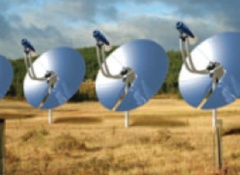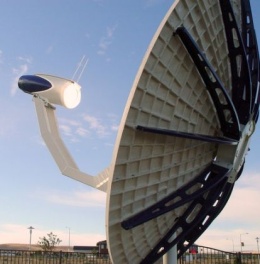 For an idea of what a sun-powered future might look like without solar panels or huge solar thermal farms, take a look at Infinia — an odd little startup I covered two months ago when it sucked in a hefty $50 million round and announced plans to start churning out dish-based systems next year.
For an idea of what a sun-powered future might look like without solar panels or huge solar thermal farms, take a look at Infinia — an odd little startup I covered two months ago when it sucked in a hefty $50 million round and announced plans to start churning out dish-based systems next year.
By some back-of-the-envelope calculations I did following another recent conversation with CEO J.D. Sitton, there’s enough free industrial capacity in the United States to manufacture over 100 gigawatts per year of the company’s solar arrays — enough power for well over 50 million people.
Got your attention? Good, but don’t expect to hear the same thing out of Infinia. The company started out planning 90MW of capacity and has since gotten enough inquiries to consider trying to make several times that amount in 2009, but has kept its outlook “very modest” despite intense interest from investors and developers.
The eye-popping 100GW figure I spun out comes not from any capability of the company, but from its scheme for manufacturing. Infinia’s solar arrays use a mirrored dish focused on a Stirling engine, in which air is heated to cause an internal cycle that produces energy. To simplify a longer explanation, the fact that it’s an engine makes it possible for automobile manufacturing plants to produce it, given a bit of re-tooling.
And according to Sitton, the nation’s auto plants, set up to churn out well over 20 million cars a year, will instead produce as few as 15 million. That leaves a lot of unused capacity (and unemployed workers; hello, Detroit) ready to build something else, capacity that Infinia is tapping into to build its first run, starting in November.
 So where most solar companies have to work incrementally, building their own plants to produce the parts they need, Infinia has the advantage of simply being able to contract out the work, and the luck of contracting it out into a market thirsty for work. The company does have limitations; it takes care of final assembly from the parts received itself, and of course has to prove that the arrays can produce power at competitive rates without problems cropping up (like the Stirling engines breaking down). Any kinks that exist will become apparent in a year or so, when the first clusters of dishes are going up.
So where most solar companies have to work incrementally, building their own plants to produce the parts they need, Infinia has the advantage of simply being able to contract out the work, and the luck of contracting it out into a market thirsty for work. The company does have limitations; it takes care of final assembly from the parts received itself, and of course has to prove that the arrays can produce power at competitive rates without problems cropping up (like the Stirling engines breaking down). Any kinks that exist will become apparent in a year or so, when the first clusters of dishes are going up.
The initial picture for Infinia does look pretty good, though. The news that prompted the conversation with Sitton is some fresh attention for Infinia from a company famous for making the iPod and iPhone — no, not Apple, but Foxconn, the company that actually builds the things. A giant Asian manufacturer, Foxconn just placed a $7 million strategic investment in Infinia, with an eye toward getting in on the dish and engine manufacturing action.
The dishes themselves produce about three kilowatts each, and when first deployed will be bunched up into groups generating between one and 10 megawatts each. The small project sizes both allow the company to skip a lengthy permitting process — the same idea that eSolar, a solar thermal company, just announced for itself — and to hook into the existing transmission grid without any modifications.
As to who’s actually making the first arrays, it’s not Foxconn. Infinia is working out the details with some North American manufacturers, with the details to be announced in a few months.

